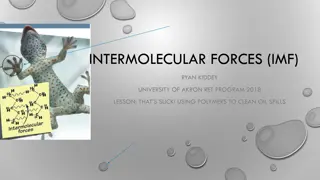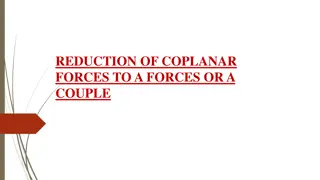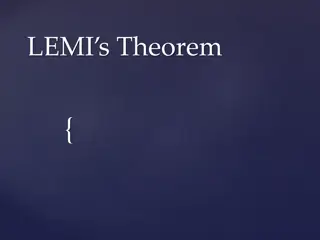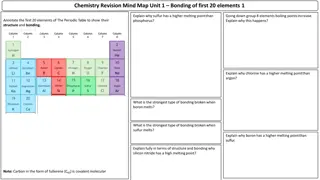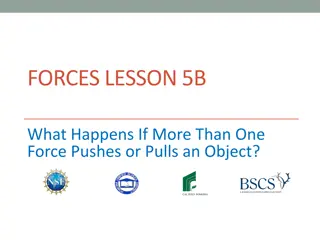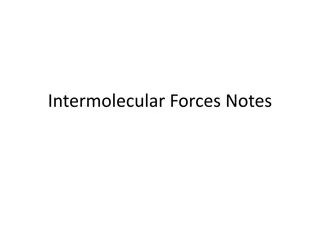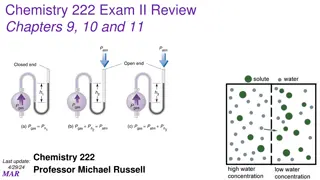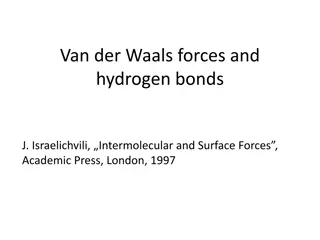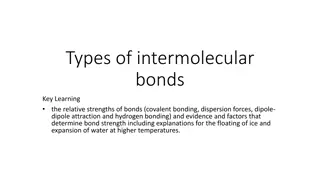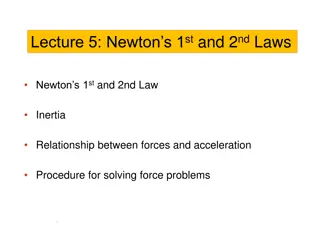Understanding Intermolecular Forces in Chemistry
Interactions between static charge distributions in chemistry are governed by Coulomb's Law, playing a crucial role in understanding intermolecular forces. From ion-ion interactions to charge-dipole and charge-quadrupole interactions, the strength of forces varies based on factors like distance and magnitude of charges. Explore the complexities and implications of these interactions in solvation processes and molecular structures.
Download Presentation

Please find below an Image/Link to download the presentation.
The content on the website is provided AS IS for your information and personal use only. It may not be sold, licensed, or shared on other websites without obtaining consent from the author. Download presentation by click this link. If you encounter any issues during the download, it is possible that the publisher has removed the file from their server.
E N D
Presentation Transcript
Intermolecular Forces One way or another, it s always Coulomb s Law: ?1?2 4 0? ? ? = presented by: Michael Morse, University of Utah morse@chem.utah.edu PowerPoints of all of my presentations to this group are available at: https://chem.utah.edu/directory/morse/research-group/index.php Just click on A/P Chemistry Powerpoints and you can download and use them as you like.
Interactions between static charge distributions I. Charge charge interactions (for example ion-ion interactions) These just follow Coulomb s Law: ? ? = The strength of the interaction depends on how close the ions get to each other (R), and the magnitude of their charges (q1 and q2). ?1?2 4 0? Crystal Charges r (in ) MP(K) NaF 1 KCl 1 RbBr 1 CsI 1 MgO 2 CaS 2 2.31 3.14 3.42 3.95 2.10 2.85 1266 1043 955 894 3125 2798 MP is not strictly proportional to q1q2/r, because other effects come into play, including the polarizability of the ions. (More about polarizability later.)
Interactions between static charge distributions II. Charge dipole interactions A dipole is a pair of charges ( qd) separated by a distance, . This generates and electric field that can be modeled by letting go to zero while qd increases so the product (qd , the dipole moment) remains fixed. The interaction then depends on the orientation of the dipole moment relative to the charge, and on the distance. ? ?,? = ?????? 1 1 ?+0.5 cos ? ? 0.5 cos ? 4??0 ? ?,? = ?????? ? 0.5 cos ? ?2 0.25 2cos2? ?+0.5 cos ? ?2 0.25 2cos2? 4??0 ? ?,? = ?????? cos ? ?2 0.25 2cos2? cos ? ?2 (assuming r >> /2) 4??0?2[ ?? is the dipole moment] 4??0 ?????? ? ?,? = ???? ? cos ? 4??0 From: Wikimedia.org Note: This interaction can be positive or negative, depending on the alignment of the dipole (cos ranges from +1 to -1). It also dies off more quickly than ion-ion interactions (1/r dependence), due to the 1/r2 dependence.
Charge-dipole interactions are responsible for solvation of ions in solvents with large dipole moments Li+ solvated by four CH3CN molecules, from a simulation of the structure of a solution. Acetonitrile (CH3CN) cannot form hydrogen bonds, but has one of the largest dipole moments of common solvent molecules (3.92 D). For comparison, the dipole moment of an isolated H2O molecule is 1.85 D; NH3 is 1.47 D; free HCl is 1.03 D; free HF is 1.91 D.
Interactions between static charge distributions III. Charge quadrupole interactions A quadrupole is a pair of dipoles arranged so their dipole moments cancel out. To represent it using equal point charges, four point charges are needed. A good example is CO2. You can think of the partially charged atoms in CO2 as the O atoms having a partial negative charge of qQ, while the C atom has a partial positive charge of +2qQ Working out the electrostatics as we did for the dipole, the interaction between an ion and a quadrupole distribution of charges (as in CO2) works out to be: ????? 4??0?3 cos2? (Only valid for r >> ) ? ?,? = Here, Q is the quadrupole moment, defined by ? = 2?? 2 (units are charge times distance squared) Because the end O atoms are negatively charged, CO2 has a negative quadrupole moment. Note: For both the charge-dipole and charge-quadrupole interactions, the forces can be much stronger at short distances (r ~ ) than these formulas would suggest.
Interactions between static charge distributions IV. Dipole dipole interactions When two dipoles interact, the strength of the interaction depends on the separation (r), the orientation of the dipoles with respect to each other, and their orientation with respect to the axis connecting them. In all fixed orientations, the attraction (or repulsion) is proportional to 1/r3. Again, this assumes the dipoles are separated by a much greater distance than the distance separating the charges within the dipole. This isn t valid when the dipolar molecules get close to one another. For dipoles of magnitude i and j, separated by a distance r, the formulas are: Optimal orientation: ?? ?? 4??0?3 ? = 2 Again, only valid when r is much larger than the charge separations within the molecules. Parallel, favorable orientation: ?? ?? 4??0?3 ? = Parallel, unfavorable orientation: ?? ?? 4??0?3 ? = Worst orientation: ?? ?? 4??0?3 ? = 2
Dipole-dipole interactions in real life We now have lots of examples of complexes between two dipolar molecules that have been examined in the gas phase using spectroscopy to determine the actual molecular structure. N C-H N C-H or (HCN)2 N C-H N C-H N C-H or (HCN)3 These species form when HCN is rapidly cooled in the gas phase, and only exist in appreciable concentration until the gas condenses.
Polarizability: A key property of atoms and molecules In all of the previous examples, I ve treated the distribution of charge within the molecule as if it is fixed and never changes in response to the environment. In fact, if an atom or molecule is placed in an electric field, the electrons move in response to that field. The molecular orbitals distort in response to the applied field, leading to an induced dipole moment. The molecule is polarizable. For a simple atom like the H atom, this can be understood by adding a small amount of 2pz character to the 1s orbital, which adds constructively on one side of the atom and destructively on the other side: The wavefunction for the H atom actually distorts in the electric field by mixing a small fraction of the 2pz orbital into the 1s orbital. Partial cancellation on the left reduces the electron density on that side; on the right side the two contributions are both positive and add in phase. The H atom distorts toward the +V plate. 1s orbital 2pz orbital -V +V
Polarizability: A key property of atoms and molecules When describing the polarization induced in an atom (or molecule) by the applied electric field, we use the expression for the total dipole moment in the presence of the applied field: ??????= ??????????+ ???????? Here, ???????? is proportional to the applied electric field: ????????= ? Polarizability, Applied electric field, Of course, if you apply a greater electric field, the molecule develops a larger induced dipole moment! The crudest model for the polarizability of an atom or molecule is to treat it like a conducting sphere with a certain volume. In this approximation, the polarizability is proportional to the volume of the sphere. This isn t exactly true for the atoms, but it is a useful fact that captures many of the trends.
Polarizabilities of the Neutral Atoms: (atomic units) 1H 4.50 2He 1.38 3Li 164 4Be 37.7 5B 20.5 6C 7N 7.4 8O 5.3 9F 10Ne 2.66 11.3 3.74 11Na 163 12Mg 71.2 13Al 57.8 14Si 37.3 15P 25 16S 19.4 17Cl 14.6 18Ar 11.1 19K 290 20Ca 161 31Ga 50 32Ge 40 33As 30 34Se 29 35Br 21 36Kr 16.8 Polarizability decreases going left to right across a period. Polarizability increases going down a column. Just like the atomic volume does!
Interactions with a polarizable charge distribution I. Charge induced dipole interactions When an ion interacts with a polarizable molecule that has no permanent dipole moment, the interaction is given by ?2? 8??0?4. ? = Here, q is the charge of the ion; is the polarizability of the neutral molecule, and r is the distance between the two. This falls off more quickly with distance than the charge-dipole interaction, because the charge has to induce the dipole. However, if the polarizability is large enough, this can become a stronger interaction overall. Examples of gas phase ion-induced dipole complexes: Complex Bond energy V+ Ar 8.76 kcal/mol Co+ Ar 11.75(2) kcal/mol Ni+ Ar 13.07(2) kcal/mol Complex V+ Kr Co+ Kr Nb+ Xe Bond energy 11.3 kcal/mol 15.4 kcal/mol 8.73 kcal/mol For comparison, the bond energy of H2 is about 10 times stronger at 104 kcal/mol; the bond energy of I2 is 36.46 kcal/mol. Are these charge-induced dipole interactions bonds? It depends on how you define a bond, which is a matter for endless debate.
Interactions with a polarizable charge distribution II. London dispersion forces (LDF) These may be understood by considering that a neutral atom or molecule that has no permanent dipole moment has an instantaneous dipole moment. The instantaneous dipole moment then causes the second molecule to polarize, leading to an induced dipole moment. The result is a net attraction between the two molecules. A better way of understanding LDFs is to note that the electronic positions in the two interacting molecules are correlated. To understand this in more detail, let s look at H2. The actual ground state wavefunction for an H2 molecule in the valence bond theory includes the standard covalent wavefunction (symbolized by (HA-HB), where A and B designate the nuclei) along with a contribution from ionic resonance structures, where both electrons are on the same atom (symbolized by (HA+ HB ) and (HA HB+)). The true ground state wavefunction is approximated as a sum of these: = 0.97 (HA-HB) + 0.18 (HA+ HB ) + 0.18 (HA HB+) The contribution of covalent character to is given by (0.97)2 = 0.94 = 94% The contribution of the ionic structure HA+ HB is (0.18)2 = 0.03 = 3% The contribution of the ionic structure HA HB+ is (0.18)2 = 0.03 = 3% The ionic resonances don t make a very big contribution to the wavefunction.
Interactions with a polarizable charge distribution II. London dispersion forces (LDF) (continued) Now suppose we have two H2 molecules arranged in a line: HA-HB HC-HD Why do these molecules attract? The full wavefunction for the system is the product of two wavefunctions, one for each molecule. This should be: = [0.97 (HA-HB) + 0.18 (HA+ HB ) + 0.18 (HA HB+)] [0.97 (HC-HD) + 0.18 (HC+ HD ) + 0.18 (HC HD+)] Molecule AB Molecule CD This gives equal probabilities of an (HA+ HB )(HC+ HD ) configuration (which is good) and an (HA+ HB )(HC HD+) configuration (which is bad). Both get a coefficient of (0.18)(0.18) = (0.18)2. What really happens is that the wavefunction responds to the nearby molecule so that the term in the product wavefunction with the (HA+ HB )(HC+ HD ) configuration is enhanced [its coefficient is greater than (0.18)2] while the term with the unfavorable (HA+ HB )(HC HD+) configuration is diminished [its coefficient is less than (0.18)2]
Interactions with a polarizable charge distribution II. London dispersion forces (LDF) (continued) An approximate formula for the potential energy for London dispersion forces between molecules A and B: ? ? = 3 ???? ??+ ?? ???? ?6 2 Here, IA and IB are the ionization energies of molecules A and B And A and B are the polarizabilities of the molecules. The ionization energy portion of this expression isn t too important, since these don t vary by more than about a factor of 2 for most molecules. Polarizabilities vary enormously, however! If we remember that polarizability is in the simplest model proportional to the molecular volume, the LDF potential is (roughly) proportional to the product of the volumes of the interacting molecules. This is why LDF forces are weak in H2 H2 interactions, but get stronger as you go to CH4 CH4, and much stronger when you get to C8H18 C8H18! For C60, the LDF force is so strong that even at 900K (1160 F), the vapor pressure is only 0.1 Torr!
A Macroscopic Example of LDFs: The Gecko s Foot ~ 3 m The tiny hairs on the gecko s foot allow a large surface area of the foot to be in contact (small R) with the wall, allowing the gecko to climb on glass or other smooth surfaces.
Hydrogen Bonds Think about a molecule like HF, for which the Lewis structure is The poor H atom only has one electron to begin with, and now it s being pulled toward the far more electronegative F atom. This leaves an empty spot on the backside of the H atom where the electron density is severely depleted. The net result in not a naked proton, but it s approaching that. This is a unique situation because hydrogen has only one electron to begin with, and now it s losing it. There is a strong electrostatic force that attracts anything with accessible electrons (lone pairs or bonds, for example; even bonds in some cases). The strongest hydrogen bonds are symmetrical, where the proton is shared equally between two anions: [F H F] Bifluoride anion, formed by passing HF gas over NaF Here the bond energy is 38.6 kcal/mol stronger than the I2 bond! This is the strongest known hydrogen bond.
Hydrogen Bonds Another symmetrical hydrogen bonded molecule is protonated 1,8-bis(dimethylamino)naphthalene: The parent molecule absorbs protons so readily (the pKa of the conjugate acid is 12.34!) that it is used in organic synthesis as a proton sponge . The proton is equally shared between the two amine groups, giving a bond order of 0.5 between the proton and each nitrogen. Symmetric sharing of the proton in hydrogen bonds is also observed in hydrogen- bonding systems under high pressure, including high-pressure ice and high-pressure formic acid.
Hydrogen Bonds Because the backside of the hydrogen atom is only exposed when highly electronegative atoms are attached, normally we think of hydrogen bonding only occurring when the H is bonded to highly electronegative F, O, or N atoms. Table of gas phase hydrogen bond energies: Molecule [F H F] [H2O H OH2]+ [H3N H NH3]+ HOH OH NH4+ OH2 HOH NH3 HOH OH2 HOH OH3+ N C-H OH2 H2N-H NH3 HSH SH2 Bond energy (kcal/mol) 38.6 (the proton-bound fluoride dimer) 33 (the proton-bound water dimer) 24 (the proton-bound ammonia dimer) 23 (water-hydroxide) 19 (the proton-bound ammonia-water dimer) 6.9 (water-ammonia) 5.0 (water dimer) 4.3 (water-hydronium) 3.8 (weak acid water) 3.1 (ammonia dimer) 1.1 (not normally considered hydrogen bonded)
Multiple Donors and Acceptors In sp3 hybridized systems, the central atom can have 0 to 4 hydrogens that can be donated and 4 to 0 lone pairs that can serve as hydrogen bond acceptors. Thus, in principle: CH4 could donate 4 hydrogens (in principle)*, but cannot accept any hydrogen bonds NH3 can donate 3 hydrogens, but can only accept 1 hydrogen bond H2O can donate 2 hydrogens, and can accept 2 hydrogen bonds HF can donate 1 hydrogen and can accept 3 hydrogen bonds Ne cannot donate any hydrogens, and can (in principle)* accept 4 hydrogen bonds Water is perfectly set up to make a hydrogen bonded network where each molecule simultaneously donates two hydrogens to form hydrogen bonds and accepts two hydrogens to form two more hydrogen bonds. Thus, each molecule participates in 4 hydrogen bonds. In HF and NH3, each molecule can only participate in two hydrogen bonds. This is why H2O is a liquid at room temperature, but HF and NH3 are gases. *from the French, En principe , meaning no .
Hydrogen bonded dimers: Many have been spectroscopically studied in the gas phase Water dimer larger water cluster geometries are also known from gas phase spectroscopic work Formic acid dimer present in the gas phase over liquid formic acid (similar structures occur for acetic acid dimer and other carboxylic acids, especially when dissolved in non-hydrogen bonding solvents) HF dimer (a very floppy structure) Cytosine-guanine (a triply hydrogen bonded system): crucial for the stabilization of the DNA double helix This structure is bound by about 21 kcal/mol! Adenine-thymine is bound by about 12 kcal/mol.
Thanks for listening! Anytime you d like to ask me a question: morse@chem.utah.edu This and all previous presentations can be found at my website: https://chem.utah.edu/directory/morse/research-group/ap_chemistry_powerpoints.php





